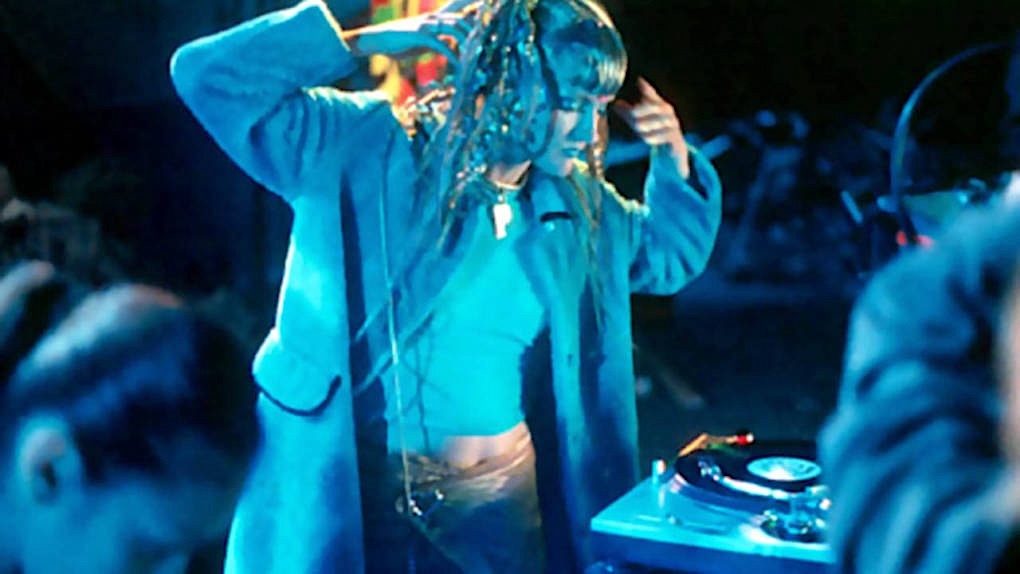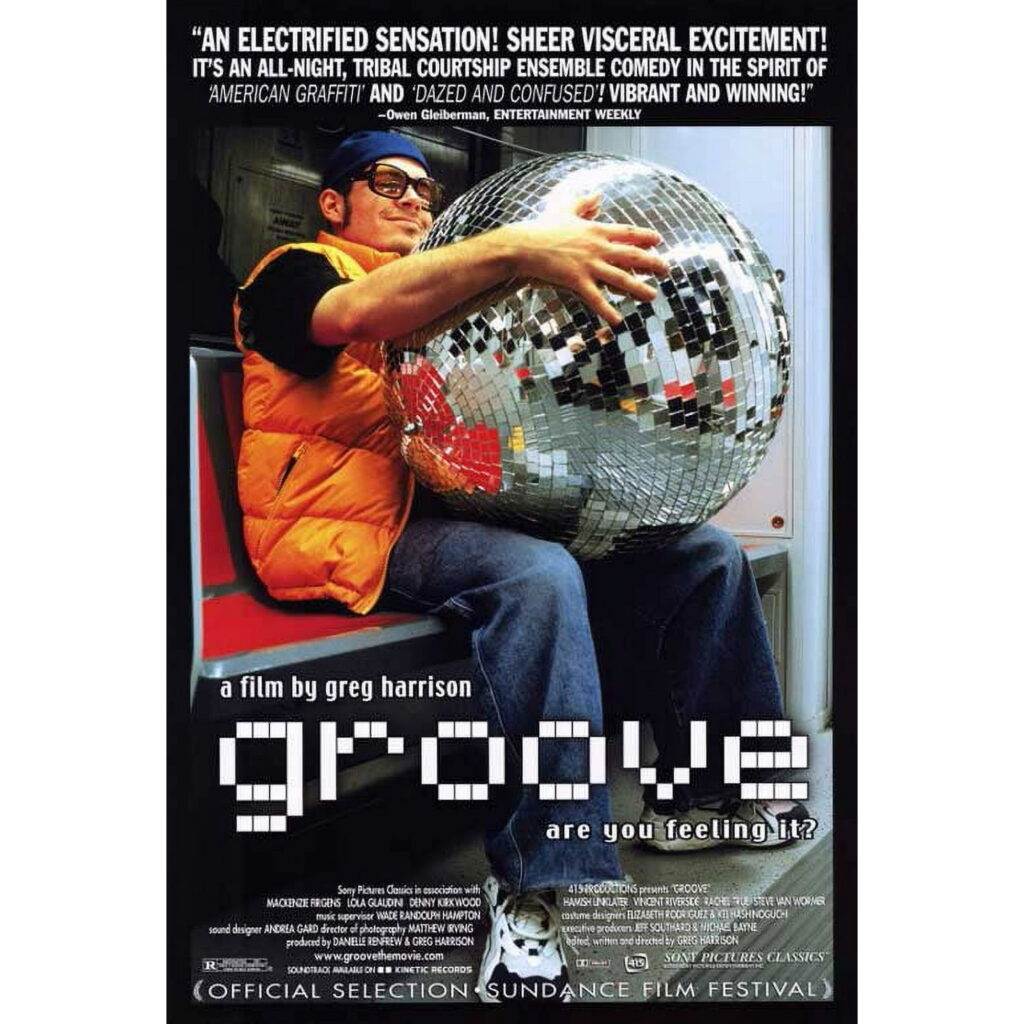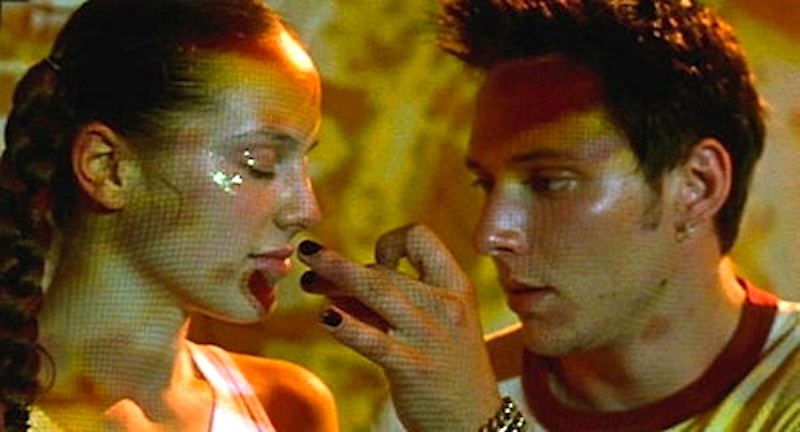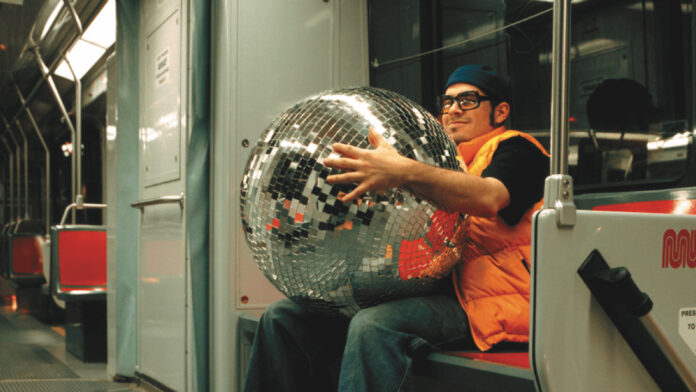Next month’s two-day screening of the 2000 cult classic San Francisco rave flick Groove at the Vogue Theatre (August 9-10) has generated a lot of online excitement. The pandemic kept the many who worked on the film from celebrating the 20th year anniversary in 2020, so think of this as a pre-party before it turns 25 next year. The movie can be viewed for free online, but this in-person weekend party is an opportune chance to see it with others and vibe.
Groove follows organizers and partygoers through one pivotal night at an illegal warehouse rave in San Francisco. The movie was directed by Greg Harrison, a Michigan State University graduate who also wrote the script, and produced by Harrison and Danielle Renfrew, the current executive producer of the Apple TV series Loot.
After a month of filming in San Francisco, Groove boogied to the Sundance Film Festival in Park City, Utah in January 2000, where the independently-produced movie was screened for the first time, and also where Sony spent $1.5 million to buy it on sight. I was there to witness the excitement, and to DJ with famous producers Richie Hawtin and King Britt at a party for Human Traffic, a similarly endearing UK film about raves that had come out the year before.
“The scene had kind of moved to the clubs by that time and we were all hanging out in clubs, we weren’t going to raves anymore,” explains Dmitri Ponce, a DJ-producer who was cast as a raver named Guy (under the name Dmitri from the Lower Haight) and became the iconic face of the poster, which shows him riding Muni while holding a giant disco ball in his lap. “I was only 20, but I was done going to warehouse raves at that time,” he remembers. “I wasn’t wearing big pants anymore; I was DJing in the clubs in San Francisco.”
The production had already signed on a number of Hollywood actors who would become much more well-known over the years, including Rachel True, Lola Glaudini, Hamish Linklater, and Nick Offerman, and Ponce was encouraged to audition for his raver authenticity. Local DJs such as Polywog, Forest Green, and Monty Luke played themselves. Watching it again almost a quarter-century later, Ponce still the top scene-stealer of the film.
“I would argue that it’s weathered pretty damn well, all things considered and I think a big part of that is what you just mentioned. Dmitri is authentic. Period. Full stop,” says the film’s music supervisor Wade Randolph Hampton, who now works as a producer for AEG Studios and AEG Global Partnerships. “That’s why he got the gig, it literally is why it holds together to this day. And there are some very bonafide performances from Nick Offerman and Rachel True, and Lola Glaudini is fantastic in it.

“You put all that together and those are the layers that you have to sum to get to a lasting piece of work. There can be flash in the pan things, there can be topics that were popular in that moment, there can be an actor that maybe is popular in a moment when that movie comes out. But sometimes it’s all the layers, and I think, in a weird way, we did hit that.”
“I remember in 1994 you would ride the bus up Haight Street and you would see nothing but ravers on the sidewalks everywhere,” Ponce recalls. “It used to be, in the mid-’90s it was really jumping, and I think that movie came out at the end of it all and it kind of served the purpose of helping to give a little resurgence and interest.
“A lot of people tell me, ‘That movie changed my life.’ A lot of them are 10 years younger than me.” Ponce is now one-half of the group Slope 114 with his wife Elise Gargalikis-Ponce. Slope 114 will release music on several acclaimed labels this year, including Doc Martin’s Sublevel Records, Roy Davis Jr.’s Undaground Therapy Muzik, and Martin Iveson’s Atjazz Record Company.
The continuously mixed Groove soundtrack encompasses diverse styles of dance music and mingles then-local acts like Ponce, Boozy & Swan, the late Scott Hardkiss, and DJ Garth & E.T.I. with UK stars such as Orbital and John Digweed (who plays himself as the revered headlining DJ in the movie). It still feels true to what was being played at the time, an embrace of homegrown sounds with English beats.
“That project just taught me so many weird things that I still tap into every day,” says Hampton, who now works on large-scale projects including live streaming Coachella. “It was just a crash course on what’s normal about soundtracks and what is abnormal and that thing is such an anomaly in so many different ways that I just feel like it’s kind of magic. It’s a bit schizophrenic, but I think that’s the difference between movies and a party a lot of days. We’re covering a lot of ground.”
Writer, director and co-producer Harrison drew a lot of inspiration for the script from SF Raves, a local Internet mailing list that presaged social media and was locally popular in the ’90s, remembers Brian Behlendorf, the founder of SF Raves and its host site Hyperreal and an investor in Groove. Behlendorf now leads initiatives at the Linux Foundation and is a board member of the Electronic Frontier Foundation.

“He was kind of quiet and lurked more than anything else, but he was collecting a lot of stories from the list,” Behlendorf says of Harrison. “Stories of people who were going to a party and it didn’t have free water and them complaining about it. Stories of people who tried to find the renegade but couldn’t find the map point then ended up dancing on the beach until dawn. Many of the small little things that ended up in the movie came from real life adventures and many of those were posted to the SF Raves list.
“I remember recognizing them as I read an early version of the script, which I thought was fun, because Greg had come back to a bunch of us who were personalities on the list and other people he knew in Silicon Valley, which was not rife with money the way it is now. It wasn’t first nature to get things funded by tech bros or anything like that. It was a little bit like, ‘Hey guys, you barely know me. I’ve been on the list, but I want to be a filmmaker. I’m making my first film and I thought I would base it on, among other things, the stories I’m hearing here.’
“He had since moved to Hollywood or spent a lot of time in Hollywood. He was trying to get it funded through the normal Hollywood channels, but had shared that he was struggling getting funding because it wasn’t a story that had a big drug overdose scene or a gang war, or something that kind of fit the expectations or stereotypes at the time.”

Says Ponce, “There were movies out like Go and other movies that featured raves in the United States, but they were cheesy because they followed the Hollywood formula where if someone does drugs then someone in the movie either has to die or someone has to go to jail. The thing that we got away with when we did Groove that’s so magical about it, is that we made a movie that was way more realistic independently, where people did drugs but we all had a good time and went home.
“Like, we had a great day and nobody died, nobody went to jail,” he continues. “And then we sold it to Sony for $1.5 million and they distributed it, so it got the distribution of a major without having to go through their rules. I didn’t even get it at the time, Wade had to point it out to me. I was so young. And it made me really, really, really appreciate the movie. I feel like we did something cool. Like, you could play that for your mom and she won’t be hating on the raves.
“Back then on the news they used to hate on the raves, they demonized us, right? So we did a nice thing, we made a nice movie.”
GROOVE August 9-10 at Vogue Theatre, SF. More info here.
Tamara Palmer is a DJ and founder of Music Book Club.






